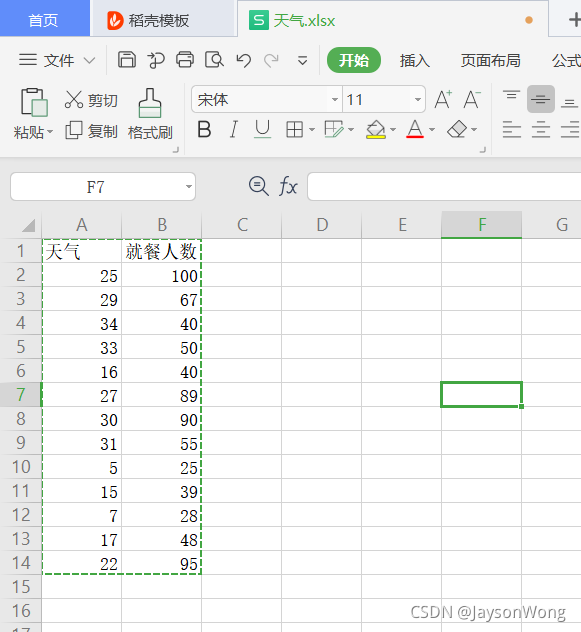梯度下降算法实战
上篇我们详细解释了梯度下降算法的数学原理,查看上篇数学原理请点击这里,本篇主要实战梯度下降算法,用一个简单的线性回归来展示梯度下降算法迷人的魅力。不懂原理党的同学也可以直接撸代码,碰到问题后再逐一查找资料,如果往更高层次的方向发展,那么数学肯定是必不可少的,必定要回归到最基础的地方。好了!废话不多说,直接上代码!
1、资料来源
资料为自己编的,当然你可以自行收集资料或者下载资料,资料如下
| 天气 | 就餐人数 |
|---|---|
| 25 | 100 |
| 29 | 67 |
| 34 | 40 |
| 33 | 50 |
| 16 | 40 |
| 27 | 89 |
| 30 | 90 |
| 31 | 55 |
| 5 | 25 |
| 15 | 39 |
| 7 | 28 |
| 17 | 48 |
| 22 | 95 |
资料为xlsx格式,保存在D盘根目录,资料图如下:

2、代码
# -*- coding: utf-8 -*-
"""
AUTHOR: jsonwong
TIME: 2021/9/17
"""
import pandas as pd
import numpy as np
import matplotlib.pyplot as plt
def data_process(file_path): # 数据处理函数
data = pd.read_excel(file_path, header=None, names=['weather', 'number'])
new_data = data.drop([0])
new_data.insert(0, 'Ones', 1)
return new_data
def vectorization(data): # 向量化函数
cols = data.shape[1]
X = data.iloc[:, 0:cols-1] # 取前cols-1列,即输入向量
y = data.iloc[:, cols-1:cols] # 取最后一列,即目标向量
X = np.matrix(X.values)
y = np.matrix(y.values)
return X, y
def ComputerCost(X, y, theta): # cost function代价函数
inner = np.power(((X * theta.T) - y), 2)
return np.sum(inner) / (2 * len(X))
def gradientDescent(X, y, theta, alpha, epoch): # 梯度下降函数
temp = np.matrix(np.zeros(theta.shape)) # 初始化一个 θ 临时矩阵(1, 2)
parameters = int(theta.flatten().shape[1]) # 参数 θ的数量
cost = np.zeros(epoch) # 初始化一个ndarray,包含每次epoch的cost
m = X.shape[0] # 样本数量m
for i in range(epoch):
# 利用向量化一步求解
temp = theta - (alpha / m) * (X * theta.T - y).T * X
theta = temp
cost[i] = ComputerCost(X, y, theta)
return theta, cost
def visualization(new_data, final_theta, *cost): # 可视化函数
x = new_data["weather"].values # 横坐标
# x = np.linspace(new_data.weather.min(), new_data.weather.max(), 6) # 横坐标
f = final_theta[0, 0] + (final_theta[0, 1] * x) # 纵坐标
plt.plot(x, f, 'r', label='Prediction')
plt.scatter(new_data.weather, new_data.number, label='Traning Data')
plt.legend(loc=2) # 2表示在左上角
plt.xlabel('weather')
plt.ylabel('number')
plt.title('Predicted')
plt.savefig('D:/predicted')
plt.show()
def iteration_figure(epoch, cost): # 迭代图像函数
plt.plot(np.arange(epoch), cost, 'r')
plt.xlabel('epoch')
plt.ylabel('cost')
plt.title('error with epoch')
plt.savefig('D:/error figure')
plt.show()
def main():
file_path = 'D:/天气.xlsx'
theta = np.matrix([0, 0]) # 初始化theta
new_data = data_process(file_path)
X, y = vectorization(new_data)
final_theta, cost = gradientDescent(X, y, theta, 0.003, 10000)
visualization(new_data, final_theta)
iteration_figure(10000, cost)
if __name__ == '__main__':
main()
3、结果
线性回归结果如下图:

可以用EXCEL画同样的拟合直线,如下图,可以看到与我们拟合的图像几乎一致(不一致,需要调整迭代次数与学习率α)

拟合过程如下图:
